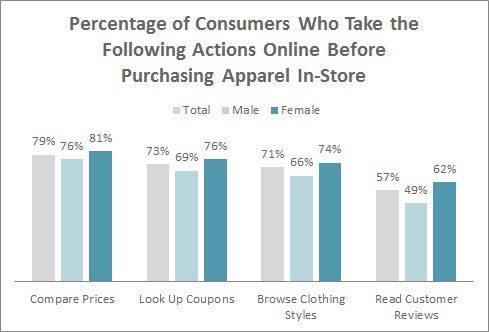Consumers may still shop at their favorite apparel stores, but increasingly they are hitting the Internet first. Some prefer to research the store’s offerings, or ask friends for their opinion – and others simply purchase the item on their laptop, iPad or phone to save themselves a trip.
Dillard’s Jerry Talamantes, communication manager, corporate brands, says online and mobile retail has not only transformed the nature of apparel shopping but is also significantly boosting sales.
[quote]”E-commerce is really slaying the dragon,” he says.
Computers, smartphones and tablets have changed the way consumers buy their apparel. Even if they do not always go in-store to make their purchase, shoppers are more engaged than ever with brands and retailers.
More than 8 of 10 consumers (85%) browse the Internet for apparel and 72% will buy online, according to the Cotton Incorporated Lifestyle Monitor™ Survey. The younger shopper is even more drawn to e-commerce: those ages 13-to-34 are significantly more likely than consumers ages 35-to-70 to browse online (91% versus 80%). Consequently, those under 35 also are more likely than older shoppers to actually buy online (79% versus 66%).
Earlier this year, Forrester Research projected online shoppers in the U.S. will spend $327 billion in 2016, up 45% from $226 billion this year and 62% from $202 billion in 2011. Driven by the increased usage of smartphones and tablets, e-commerce is expected to account for 9% of total retail sales by 2016, up from 7% in both 2012 and 2011, according to Forrester.
BDO USA’s survey of retail CFOs predicts a 5.9% increase in total 2012 online sales, compared to 4.1% and 4.5% year ago increases in comparable store sales and total sales, respectively.
The ease that comes with shopping on an iPhone or Android is not lost on U.S. Shoppers. comScore reports nearly 110 million Americans owned a smartphone device by April of this year, up 44% from 2011. And whether online or on a device, the number of consumers browsing or buying online is expected to surpass 200 million by 2015, according to eMarketer. Men, women and kids are all part of the e-retail generation.
The NPD Group’s Marshal Cohen, chief industry analyst, says even men enjoy the benefits of a second opinion, especially the younger set.
“Men used to have a huge phobia that an outfit or an item didn’t work,” Cohen says. “Now, they can go online and do ‘pre-search’ to know what they want to look like. And they can easily get a second opinion by asking someone online — be it a friend or fashion guru. They can even send a picture of what they’re thinking of buying, get approval and buy it. It’s a piece of cake.”
Retailers can also count on shoppers using their mobile or smartphones to shop for holiday gifts this year. The Monitor finds 63% say they will use it to comparison shop (down from 82% in 2011), followed by “to locate stores” (52%), purchase items (49% — up significantly from 28% in 2011) and read customer reviews (37%).
Although just 25% of shoppers write product reviews, 87% read reviews when shopping for apparel online and 57% do so even when shopping in-store, according to the Monitor.
Avid online and mobile users include tweens and teens. The National Retail Federation’s Mike Gatti, spokesperson, says even though kids cannot make the e-purchase for themselves, they are using the Web to make apparel choices.
“The big retailers view online as a dual consumer relationship, so they’re building communities on their sites,” Gatti says. “They build a site that is age appropriate for kids with games and product. And they also build it so parents can go in and see what their kids are interested in. And this helps build collaborations within the families. Some of it is budget training for kids, because parents tell them they have a certain amount they can spend and the parents have to approve it before they buy.”
And, of course, price is a key factor for everyone when looking up a product before buying. While shopping for clothes online, 81% of consumers look at the price in general to tell them about a product, followed by information on sizing (69%), color (63%), style (57%), discount coupons (50%) and shipping promotions (50%), Monitor data reveal.
“The intelligent consumer uses technology to price compare,” says BDO’s Stephen Wyss, partner in the retail and consumer products practice. “And that makes it difficult for retailers to not have promo activity.”
Despite the growth in e- and m-commerce, consumers still have some concerns. Nearly 9 of 10 shoppers (89%) are “very or somewhat concerned” about shipping costs. Other concerns include not being able to try on the clothes (74%) and not being able to physically touch the clothes (60%), according to Monitor data.
“It’s changing retail in the face-to-face social side that we’ve all enjoyed so much,” Talamantes says. “It’s being morphed by e-commerce trade. That’s one of the big effects, that tangible connection with seeing a salesperson and touching the garments.
“E-commerce is a boon,” Talamantes says, “and this change in business is very interesting.”

